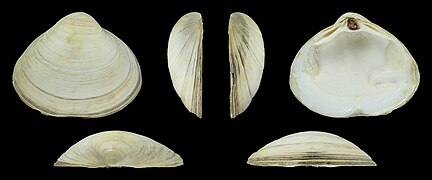Brief Summary
provided by Ecomare
As the name indicates, thick trough shells are robust medium-sized shells. Single or double valves wash ashore regularly. Living or recently dead specimen sometimes wash ashore after a storm or frost. When fresh, they are white to grayish white. Older specimen are usually discolored and often wash ashore during sand supplementation.
- license
- cc-by-nc
- copyright
- Copyright Ecomare
Spisula solida: Brief Summary
provided by wikipedia EN
The surf clam (Spisula solida) is a medium-sized marine clam, or bivalve mollusc, found in the Eastern Atlantic from Iceland and northern Norway to Portugal and Spain. Up to 5 centimetres (2.0 in) long, like many clams, the surf clam is a sediment-burrowing filter feeder.
Right and left valve of the same specimen:

Right valve

Left valve
This species of clam is found in sandy bottom in the sublittoral zone. It is commonly found in the North Sea, Baltic Sea and the Irish Sea.
- license
- cc-by-sa-3.0
- copyright
- Wikipedia authors and editors
Description
provided by World Register of Marine Species
A thick oval shell, mostly coloured dirty white and measuring up to 50 mm long. Concentric lines at the front and back are reasonably coarse, growth lines are clear. A shallow burrowing suspension feeder.
Degraer, S.; Wittoeck, J.; Appeltans, W.; Cooreman, K.; Deprez, T.; Hillewaert, H.; Hostens, K.; Mees, J.; Vanden Berghe, E.; Vincx, M. (2006). The macrobenthos atlas of the Belgian part of the North Sea. Belgian Science Policy. D/2005/1191/3. ISBN 90-810081-6-1. 164 pp.
- license
- cc-by-4.0
- copyright
- WoRMS Editorial Board
Distribution
provided by World Register of Marine Species
With observations in the coastal zone up to in the open sea the distribution of Spisula solida covers the entire Belgian part of the North Sea. The species is mainly found on the tops of the sandbanks. During the 1976-1986 period S. solida was found in a relatively high number of locations. In the 1994-2001 period, however, the distribution frequency decreased considerably. In both periods S. solida reached a maximum density of 40 ind./m2.
Degraer, S.; Wittoeck, J.; Appeltans, W.; Cooreman, K.; Deprez, T.; Hillewaert, H.; Hostens, K.; Mees, J.; Vanden Berghe, E.; Vincx, M. (2006). The macrobenthos atlas of the Belgian part of the North Sea. Belgian Science Policy. D/2005/1191/3. ISBN 90-810081-6-1. 164 pp.
- license
- cc-by-4.0
- copyright
- WoRMS Editorial Board
Habitat
provided by World Register of Marine Species
Spisula solida mainly prefers coarse-grained sediments: the higher the median grain size, the higher the relative occurrence (up to 20%). The species furthermore also tends to prefer the presence of a low mud content (0-20%). The species does not occur in sediments with a mud content exceeding 20%.The high relative occurrence (20%) in sediments with a median grain size of 50-100 µm is considered unreliable (outlier).
Degraer, S.; Wittoeck, J.; Appeltans, W.; Cooreman, K.; Deprez, T.; Hillewaert, H.; Hostens, K.; Mees, J.; Vanden Berghe, E.; Vincx, M. (2006). The macrobenthos atlas of the Belgian part of the North Sea. Belgian Science Policy. D/2005/1191/3. ISBN 90-810081-6-1. 164 pp.
- license
- cc-by-4.0
- copyright
- WoRMS Editorial Board
Validity
provided by World Register of Marine Species
Valid as Spisula (Spisula) solida (Linnaeus, 1758)
Howson, C.M. & B.E. Picton. (1997). The species directory of the marine fauna and flora of the British Isles and surrounding seas. Ulster Museum Publication, 276. The Ulster Museum: Belfast, UK. ISBN 0-948150-06-8. vi, 508 (+ cd-rom) pp.
- license
- cc-by-4.0
- copyright
- WoRMS Editorial Board



